Article
Diabetes Stewardship Pharmacist Model Demonstrates Benefits to Patient Outcomes and Cost
Author(s):
Diabetes and stress-induced hyperglycemia affect an estimated 30% to 45% of all hospitalized patients.
A diabetes stewardship is an innovative pharmacy model that utilizes the talent and expertise of pharmacists to improve and optimize glycemic outcomes within a large, at-risk patient population, according to a poster presented at the American Society of Health-System Pharmacists' (ASHP) virtual 2020 ASHP Midyear Clinical Meeting and Exhibition.
Diabetes and stress-induced hyperglycemia affect an estimated 30% to 45% of all hospitalized patients. Hyper- and hypoglycemia occurrence in patients who are hospitalized have demonstrated adverse outcomes, including increased health care expenditure, longer lengths of stay, higher mortality, and greater odds of being discharged to a skilled nursing facility.
According to the study authors, insulin is the recognized treatment of choice but is also identified as a high-risk medication. Further, professional organizations have endorsed pharmacist involvement in the delivery of acute glycemic management of hospitalized patients. The institution of a pharmacist-led diabetes stewardship is a novel approach, but one that is essential and highly impactful.
The objective of the study was to develop a pharmacy stewardship model to reduce patient harm related to insulin administration, optimize institutional glucometric outcomes, ensure health care providers within the institution are up to date in their knowledge and approach to treating glycemic excursions in the hospital, and enhance education efforts across all the interprofessional service-lines within the organization.
In addition, the researchers constructed a real-time surveillance tool embedded within the electronic health record (EHR) allowing:
- Efficient identification of patients with glycemic excursions
- Enhanced ability to triage patient care
- Improved delivery of evidence-based pharmacotherapeutic recommendations.
The EHR system enhancements that were implemented are aimed to help the frontline pharmacy colleagues caring for this complex patient population, according to the study authors.
The stewardship was initiated in January 2016 and collaborates with service-line aligned clinical pharmacists, medical residents across the organization, diabetes education coordinators, and EHR system analysis, according to the study authors.
Some of these services are as follows:
- Constructing, developing, and maintaining institutional policies, procedures, and order-sets related to acute glycemic management
- Actively monitoring and delivering just-in-time intervention, recommendations, and education to front-line colleagues
- Serving as the preceptor for a PGY-1 elective rotation
As for experience with the program, the Society of Hospital Medication Glycemic Control eQUIPS Program collected data from January 2015 to June 2020. The percentage of patient days with hypoglycemia occurrence was greater than 75% relative risk reduction. Additionally, in terms of the percentage of patient stays with hypoglycemia occurrence, relative risk reduction was 64.2% in critical care and 48.76% in non-critical care.
The results found the pharmacist credentialing series related to acute glycemic management would be a 2-part series, with EHR system enhancements, pharmacy rounding checklist, and RX quick documentation tool to capture interventions, according to the study authors.
In the nursing perspective, there was a retooled delivery of diabetes education, finding nursing audits capturing a 178% improvement in the percentage of education provided to eligible inpatients. In January 2019, 48% of the patients were educated, whereas 82% of patients were educated in July 2020. The construction and delivery of a live, in-person insulin titration course is still ongoing, and more than 500 nurses have completed the course.
The study authors concluded that this program has demonstrated vast improvements in patient safety, cost avoidance, and clinical efficacy outcomes. Further, they noted that the pharmacy stewardship model is easily translatable to other organizations or other high-risk patient populations.
REFERENCE
Knezevich J, Malashock C, Drinicic A, et al. Impact of a novel diabetes stewardship pharmacist model on enhancing inpatient safety, outcomes, and cost avoidance. Poster presented at American Society of Health-System Pharmacists' virtual 2020 ASHP Midyear Clinical Meeting and Exhibition; December 6-10, 2020. Accessed December 14, 2020.
Newsletter
Stay informed on drug updates, treatment guidelines, and pharmacy practice trends—subscribe to Pharmacy Times for weekly clinical insights.






